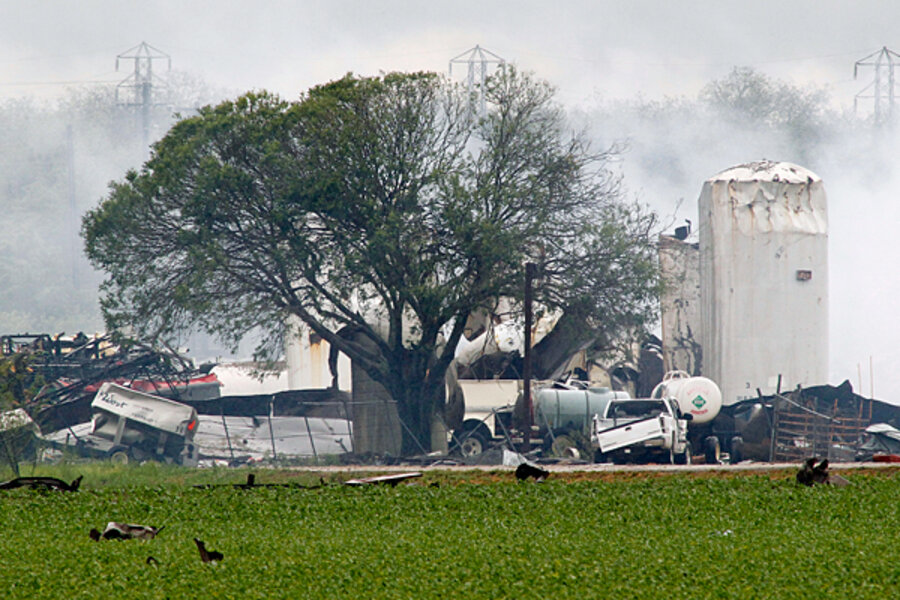Texas fertilizer plant blast: Was it 'freak accident' that tore town apart?
Loading...
| Atlanta
Search and rescue teams combed the devastated town of West, Texas Thursday after a massive explosion at a fertilizer plant killed as many as 15 people, including several volunteer firefighters, injured nearly 200 more residents, and destroyed dozens of homes.
While the timing and nature of the explosion aroused suspicions, coming after the Boston Marathon bombing and near the anniversaries of both the Waco Siege of 1993 and the Oklahoma City bomb in 1995, authorities and residents are leaning more heavily toward the theory that the fire and ensuing mushroom-cloud-causing explosion amounted to a tragic accident.
“It was one of them freak accidents,” an employee at Bud’s gas station said in a brief phone interview. “We’ve got a lot of damage.”
The explosion occurred around 8 p.m. local time, 24 minutes after volunteer fire crews responded to a wind-fueled fire at the plant, which is located near a school, a residential neighborhood, and a retirement center, all of which sustained major damage in a blast that measured 2.1 on the Richter scale and could be felt in towns nearly 50 miles away.
Officials were zeroing in on a train car packed with ammonium nitrate as the main cause of the explosion.
“Today our prayers go out to the people of West, Texas, in the aftermath of last night’s deadly explosion at a fertilizer plant,” President Obama said in a statement. “A tight-knit community has been shaken, and good, hard-working people have lost their lives.”
Videos of the fire and explosion show the blunt force of the explosion of ammonium nitrate, one of the most common and dangerous chemicals on the open market. A similar plant explosion killed 31 and injured more than 1,200 in Toulouse, France, in 2001. One of the deadliest industrial accidents of all time was in Texas City, Texas, in 1947, when an ammonium nitrate explosion killed 581 people.
In West, law enforcement on the scene likened the damage to the appearance of the Alfred P. Murrah Federal Building in Oklahoma City after a domestic terrorist set off a bomb there in 1995, killing 168 people. That bomb, too, was constructed in part using ammonium nitrate. While federal authorities cracked down on the substance after that explosion, it is still widely produced and used for agriculture in the US.
Videos of the West incident gave Americans the second glimpse in a week, following footage of the Boston Marathon bombs, of the power of war-like explosions. In one video posted on YouTube, a father and daughter are filming the fire from about 300 yards away when the plant explodes, lifting their truck and scrambling the passengers. The girl, Khloey Hurtt, can be heard on the video pleading with her dad to, “Please get out of here. I can’t hear anything.”
As searches continued Thursday. Texas sent more resources into the town of 2,800 people north of Waco, including urban search and rescue teams and mobile medical units.
The Environmental Protection Agency had cited the West Fertilizer Company in 2006 for failing to obtain or qualify for a permit following complaints of a strong ammonia smell. In an emergency plan prepared by the company, it said the worst thing that could happen was a short, harmless release of ammonia into the air. Fertilizer plants in Texas have been inspected six times in the last five years, but none of those inspections took place at the West Fertilizer Co., according to the United States Department of Labor.
According to press reports, Texas officials say they have no evidence to suggest foul play in the explosion, but teams of federal agents are still investigating whether a crime took place.
West, which bills itself as “The Czech Point of Central Texas,” was founded by Czech immigrants in 1892, and is today a destination for tourists seeking classic Czech cuisine and baked goods. A local road is named for iconic country singer Willie Nelson, who considers central Texas his home.
As volunteers and rescue workers descended on the area on Thursday, however, it fell largely on Bush’s Chicken on Oak Street to help feed the multitudes. “We’re very busy right now, can’t talk,” one employee at the small eatery said. “We’re feeding about the whole town of West.”








